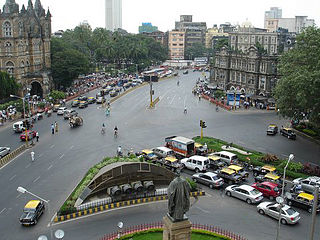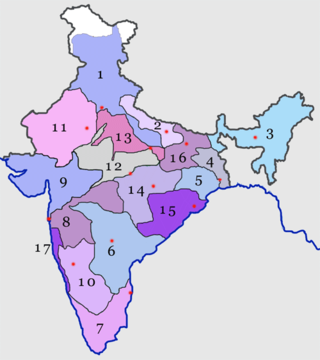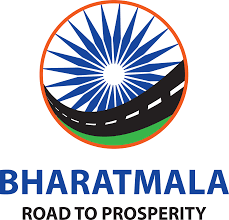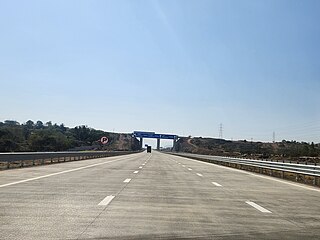
Transport in Mumbai is achieved by both public, and private transport. As of 2015, 52% of commuters use public transport. Mumbai has the largest organized bus transport network among major Indian cities.

Central Railway is one of the 19 zones of Indian Railways. Its headquarters is in Mumbai at Chhatrapati Shivaji Maharaj Terminus. It has the distinction of operating the first passenger railway line in India, which opened from Mumbai to Thane on 16 April 1853.

Reliance Infrastructure Limited (R-Infra), formerly Reliance Energy Limited (REL) and Bombay Suburban Electric Supply (BSES), is an Indian private sector enterprise involved in power generation, infrastructure, construction and defence. It is part of the Reliance Anil Dhirubhai Ambani Group. The company is headed by its chairman, Anil Ambani, and chief executive officer, Punit Narendra Garg. The corporate headquarters is in Navi Mumbai. Reliance Infrastructure's interests are in the fields of power plants, metro rail, airports, bridges, toll roads, and defence. It is a major shareholder in the other group company, Reliance Power and Reliance Naval and Engineering Limited.
The Harbour line is a branch line of the Mumbai Suburban Railway operated by Central Railway. It was named so because it catered to the eastern neighbourhoods along the city's natural harbour. Its termini are Chhatrapati Shivaji Maharaj Terminus (CSMT), Goregaon and Panvel on the CSMT-Goregaon, CSMT-Panvel and Panvel-Goregaon routes.
The Western Freeway was a proposed controlled-access highway in Mumbai, India that would stretch from Marine Drive in South Mumbai to Kandivli in the north, a distance of 29 km. The project envisioned the construction of four major sea links over the Arabian Sea along Mumbai's western coastline to reduce traffic-congestion between the Western Suburbs and South Mumbai.

The Mumbai–Pune Expressway is India's first 6-lane wide concrete, access-controlled tolled expressway. It spans a distance of 94.5 km connecting Raigad-Navi Mumbai-Mumbai, the capital of Maharashtra state and the financial capital of India, with Pune, the cultural and educational capital of Maharashtra. The expressway, which was fully operationalized in 2002, introduced new levels of speed and safety in automobile transportation to Indian roads. It is one of India's busiest roads.

The Airoli Bridge is a bridge in the Mumbai Metropolitan Region of India. It was constructed to establish a direct road link between Mumbai and Navi Mumbai.

The Bandra-Worli Sea Link is a 5.6 km long, 8-lane wide cable-stayed bridge that links Bandra in the Western Suburbs of Mumbai with Worli in South Mumbai. It is the longest sea bridge, as well as the 5th longest bridge in India after Mumbai Trans Harbour Link, Bhupen Hazarika Setu, Dibang River Bridge and Mahatma Gandhi Setu. It contains pre-stressed concrete-steel viaducts on either side. It was planned as a part of the proposed Western Freeway that would link the Western Suburbs to Nariman Point in Mumbai's main business district, but is now planned to become part of the Coastal Road to Kandivali.

The Western Express Highway, abbreviated to WEH, is a major north–south 8-10 lane arterial road in Mumbai, India, stretching from the suburb of Mira Road to Bandra. The 25.33 km (15.74 mi) highway begins near the Mahim Creek and extends to the Kashimira in the northern limit of the city till it connects National Highway 48 at Ghodbunder village. The road connects the city of Mumbai to its suburbs, including the Chhatrapati Shivaji Maharaj International Airport.

Expressways are the highest class of roads in India. In July 2023, the total length of expressways in India was 5,579 km (3,467 mi), with 8,366 km (5,198 mi) under construction. These are controlled-access highways where entrance and exits are controlled by the use of cloverleaf or trumpet or grade separated interchanges that are incorporated into the design of the expressway and designed for maximum speed of 120 km/h, whereas National highways are flyover access or tolled, where entrance and exit is through the side of the flyover, at each intersection of highway with road, flyovers are provided to bypass the city/town/village traffic and these highways are designed for speed of 100 km/h. Some roads are not access-controlled expressways but are still named expressways, such as the Biju Expressway, these are actually state highways that are not declared by the central government as an Expressway, hence not an Expressway or National Highway.
The Western Railway Elevated Corridor, also known as the Oval Maidan-Virar elevated corridor, was a proposed rapid transit corridor that would have run along the same alignment as the Western Line of the Mumbai Suburban Railway, and link Oval Maidan with Virar.

The Mumbai Trans Harbour Link, officially named as Atal Bihari Vajpayee Sewri–Nhava Sheva Atal Setu and colloquially known as Atal Setu, is a 21.8 km (13.5 mi) 6-lane elevated highway bridge, which connects Mumbai with Navi Mumbai, its satellite city. It is the longest sea bridge in India, and the world's 12th longest sea bridge. The bridge begins in Sewri, South Mumbai, crosses Thane Creek north of Elephanta Island, and terminates at Chirle near Nhava Sheva in Uran taluka, Navi Mumbai. The road is linked to the Mumbai–Pune Expressway in the east and to the Coastal Road in the west. The 6-lane highway is 27 meters in width, in addition to two emergency exit lanes, two edge strips, parallel crash barriers and noise barriers on both sides. The project costs a total of ₹17,843 crore (US$2.2 billion). The bridge has a capacity to handle 70,000 vehicles per day. Construction on the bridge began in April 2018, and was inaugurated by Prime Minister Narendra Modi on 12 January 2024.
The Sion Panvel Expressway is a 25 km Indian highway located entirely in the state of Maharashtra, that connects Sion in Mumbai with Panvel, via Navi Mumbai. It is one of the busiest and most important roads in the Mumbai Metropolitan Region (MMR) and connects Mumbai with the city of Pune. The National Highway 4 and Mumbai-Pune Expressway begin at the eastern end of the expressway, at Kalamboli junction, near Panvel. The highway is also used by vehicles traveling towards Mumbai from Konkan and Goa.
Station Area Traffic Improvement Scheme (SATIS) is a World Bank funded station area traffic improvement project. It is implemented by Mumbai Metropolitan Region Development Authority (MMRDA) and Thane Municipal Corporation. This project is executed under Mumbai Urban Transport Project road component. The project aims at easing commuter and pedestrian movement by building skywalks, foot over bridges, separate parking areas for auto-rickshaws and taxis at four crowded suburban railway stations Borivali, Dadar, Chembur and Ghatkopar implement by MMRDA and Thane SATIS is implemented by Thane Municipal Corporation. On 22 October 2022, MMRDA announced new SATIS implementation at Ambernath railway station.
The Mumbai Metropolitan Region Development Authority (MMRDA) is a body of the Government of Maharashtra that is responsible for preparation of Regional Plan for MMR and the infrastructure development of the Mumbai Metropolitan Region. The MMRDA was created on 26 January 1975 under the Mumbai Metropolitan Region Development Authority Act, 1974 Government of Maharashtra. The agency is responsible for planning and coordination of development activities in the Region.
Kherwadi Social Welfare Association commonly abbreviated as KSWA is a nonprofit organization in India. KSWA aims to restore Upliftment of underprivileged youth in India. The organization was established in 1928. Yuva Parivartan offers different vocational training Programs for the underprivileged youth. This movement was started to help the unmotivated school dropouts to become economically independent by imparting livelihood skills to them.
Maharashtra is a state in western India. It is the country's second-most-populous state and third-largest state by area. Maharashtra is bordered by the Arabian Sea on the west, Gujarat and the Union territory of Dadra and Nagar Haveli on the northwest, Madhya Pradesh on the north and northeast, Chhattisgarh on the east, Karnataka on the south, Telangana on the southeast and Goa on the southwest. The state covers 307,731 km2 (118,816 sq mi), or 9.84 percent of India's total area.

The Bharatmala Pariyojna is an ongoing project that will interconnect 550 District Headquarters through a minimum 4-lane highway by raising the number of corridors to 50 and move 80% freight traffic to National Highways by interconnecting 24 logistics parks, 66 inter-corridors (IC) of total 8,000 km (5,000 mi), 116 feeder routes (FR) of total 7,500 km (4,700 mi) and 7 north east Multi-Modal waterway ports. The project also includes development of tunnels, bridges, elevated corridors, flyovers, overpass, interchanges, bypasses, ring roads etc. to provide shortest, jam free & optimized connectivity to multiple places, it is a centrally-sponsored and funded Road and Highways project of the Government of India. This ambitious umbrella programme will subsume all existing Highway Projects including the flagship National Highways Development Project (NHDP), launched by the Atal Bihari Vajpayee government in 1998. Bharatmala is mainly focused on connecting remote areas and satellite cities of megacities such as Bengaluru, Pune, Hyderabad etc. The total investment for 83,677 km (51,994 mi) committed new highways is estimated at ₹10.63 lakh crore (US$130 billion), making it the single largest outlay for a government road construction scheme. The project will build highways from Maharashtra, Gujarat, Rajasthan, Punjab, Haryana and then cover the entire string of Himalayan territories - Jammu and Kashmir, Himachal Pradesh, Uttarakhand - and then portions of borders of Uttar Pradesh and Bihar alongside Terai, and move to West Bengal, Sikkim, Assam, Arunachal Pradesh, and right up to the Indo-Myanmar border in Manipur and Mizoram. Special emphasis will be given on providing connectivity to far-flung border and rural areas including the tribal and backward areas.

The Samruddhi Mahamarg or Nagpur-Mumbai Expressway and Maharashtra Expressway-2 (ME-2), is a partially opened 6-lane wide, 701-km long access-controlled expressway in Maharashtra, India. It is amongst the country's longest greenfield road projects, which will connect the two capital cities of the state, its capital, Mumbai, and its third-largest and alternate capital city, Nagpur. The project is being led by the state infrastructure arm Maharashtra State Road Development Corporation (MSRDC), and is designed under the Engineering, Procurement and Construction (EPC) model.
The Versova–Bandra Sea Link (VBSL), officially Swatantrya Veer Savarkar Sea Link, is an under-construction bridge in Mumbai, Maharashtra, India as a part of Coastal Road Phase-2. The 17.17-kilometre (10.67 mi) bridge will connect Versova, a neighbourhood in the suburb of Andheri to the Bandra–Worli Sea Link in Bandra, as part of the Coastal Road. The 8-lane sea link is expected to reduce congestion on the Western Express Highway and the Western Line of the Mumbai Suburban Railway.












